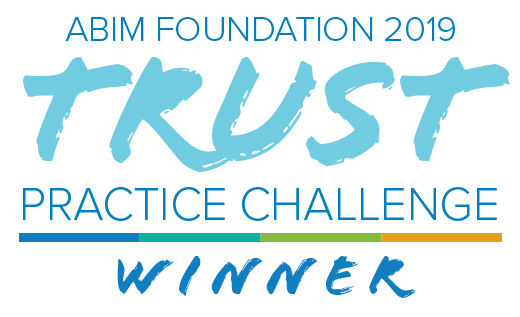Graphic Medicine to Empower Patients & Promote Trust in Clinician Electronic Health Records Use

In January 2019, the ABIM Foundation launched its Trust Practice Challenge, an initiative to address the “trust gap” in health care by identifying practices that foster trust and trustworthiness in various aspects of the health care system. The Foundation would later launch Building Trust to build on this open call.
The creation of a comic encouraging patients to speak with their clinicians about their electronic medical records helped patients understand that they can ask their doctor questions without fear or worry about appearing as challenging or “difficult.” How does this build trustworthiness? Patients feel greater trust in their care team when they believe the team views their involvement positively, and patients ultimately have an increased understanding of their health and increased satisfaction with the decisions they make with their doctor.
How It Works
The practice we developed and implemented at the University of Chicago was designed to improve patients’ knowledge of their role with regard to the EHR, and to empower them to take part in EHR self-advocacy behaviors during clinical interactions.
We serve a diverse patient population, so we needed an educational vehicle that was effective and could cater to our varied population. Given graphic medicine’s success as a medium for patient education, we developed a comic based on prior published studies and systematic reviews, including our own, on the EHR’s impact on the patient-provider relationship and communication. This led us to identify three core advocacy behaviors patients and family members should be aware of in order to promote a more collaborative and patient-centered EHR interaction with their doctors.
Our comic is entitled “Computers in the Clinic: YOUR ROLE!” and the first advocacy behavior is “A – Ask to see the screen.” This is followed by “B – Become Involved. Review your records with your doctor and ask questions.” and “C – Call for Attention. If you have something sensitive to discuss, speak up and ask for your doctor’s full attention.”
The comic orients patients to their role with the EHR and invites them to practice behaviors to help promote patient-doctor-EHR engagement. Using technology as an educational tool to facilitate discussion and understanding creates important opportunities for shared decision making and increased patient satisfaction. We believe this kind of patient empowerment can foster transparency, collaboration, and trust in the patient-provider relationship.
Skills and Competencies
If patients are going to engage in clinician EHR use, physicians must be facile with the EHR so they can easily and meaningfully use it real-time with patients. Furthermore, institutions must recognize the burdens of EHR use, particularly after hours, and its impacts on provider burnout. EHR communication skills and efficiency training is critical, as is team support to help tackle non-clinician EHR work. This between-visit assistance can be invaluable for patients, letting them know they have their healthcare team’s support beyond their clinic visits, and for clinicians in order to support wellness and promote joy in their practice of medicine.
Origins
Our personal professional experience as well as formal study of the EHR’s impact on the patient-provider relationship has shown while there are potential negative impacts on patient satisfaction and communication, there are positive ways the EHR can improve these same measures. We have sought to gather these “best practice” behaviors and leverage them create a longitudinal curriculum for trainees as well as faculty on how to use the EHR to promote patient engagement, understanding, and shared decision making.
Although we have had success in disseminating our work, we realized that the most important member of the patient-provider relationship, the patient, was not an active part of our educational efforts. In order to better engage patients and involve them in this process, we sought to directly promote patient EHR self-advocacy, which led us to the creation of the comic. To date, our research is the first to address this important subject area. We have since studied our comic among adult primary care and parents of pediatric patients at the University of Chicago during check-in for their primary care visits, including phone follow-up calls from each cohort to understand impacts of the comic over time.
Effectiveness
Nearly 3/4 of adult patients (115/162) and pediatric parents (224/313) agreed the comic encouraged EHR involvement. African American and Hispanic participants were more likely to ask to see the screen and become involved in EHR use due to the comic (adult P=.01, P=.01; parent P=.02, P=.006, respectively). Lower educational attainment was associated with increases in parents asking to see the screen and to be involved (ρ=−0.18, P=.003; ρ=−0.19, P<.001, respectively) and adults calling for physician attention (ρ=−0.17, P=.04), which was confirmed in multivariate analyses.
Phone-follow up showed impacts on subsequent visits. Adult and pediatric parents increasingly asked to see the screen (median 3 vs 4, P=.006, P<.001 respectively), and parents thought the comic encouraged increased involvement with physician computer use (median 4 vs 4, P=.02), called for physician attention (median 3 vs 4, P<.001) and felt more empowered to get involved with computer use at future visits (median 3 vs 4, P<.001).
Comments suggesting the comic promoted fundamental components of a trusting relationship included; “The comic was great because I didn’t know it was my right to look at the computer”” and “Patients often feel like they are rushed, the comic gives assurance that its okay to ask questions.”
Scalability
Our leadership is supporting operationalizing its use across all clinics within our care network and it is scalable and freely available to other organizations. It is easily read and understood by various literacy and educational levels, and can be translated into other languages. It is compact and can be distributed and featured in high visibility settings such as in waiting rooms or online on the patient portal. Further, the comic requires no explanation, can be easily given to patients on check in by non-medical front desk providers or medical assistants, and can be quickly read prior to a patient’s visit.

